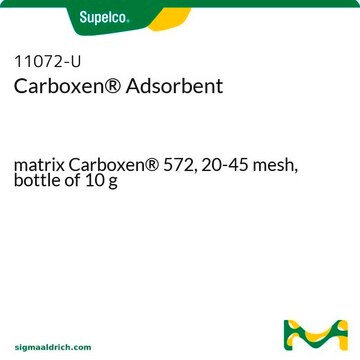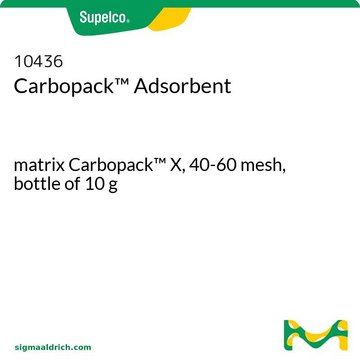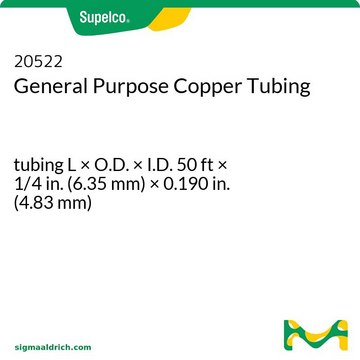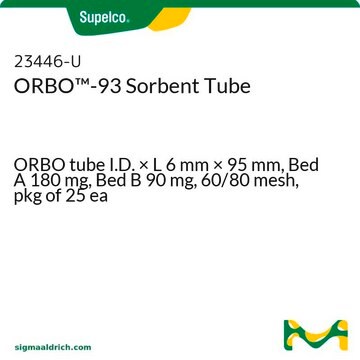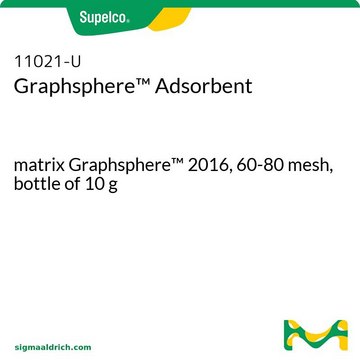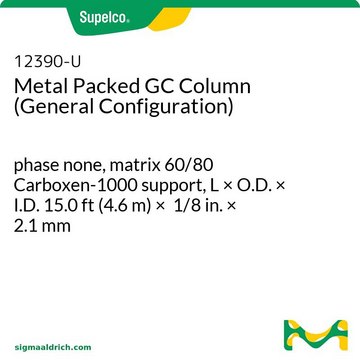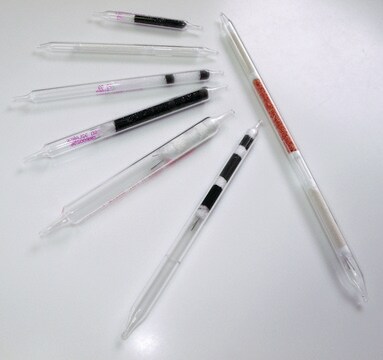10477-U
Carboxen® Carbon Adsorbent
matrix Carboxen® 1000, 40-60 mesh, bottle of 50 g
Synonim(y):
adsorbent węglowy, GCB, 60-80 mesh
About This Item
Polecane produkty
Nazwa produktu
Carboxen® Adsorbent, matrix Carboxen® 1000, 40-60 mesh, bottle of 50 g
linia produktu
Carboxen®
Formularz
powder
opakowanie
bottle of 50 g
metody
LPLC: suitable
powierzchnia
~1200 m2/g
Matryca
Carboxen® 1000
grupa aktywna macierzy
carbon
wielkość cząstki
40-60 mesh
wielkość porów
~0.16 cm3/g mesoporosity
~0.25 cm3/g macroporosity
~0.44 cm3/g microporosity
~10-12 Å pore diameter
gęstość
~0.50 g/mL (free fall density)
metoda separacji
reversed phase
Szukasz podobnych produktów? Odwiedź Przewodnik dotyczący porównywania produktów
Opis ogólny
Zastosowanie
- Ocena wybranych stałych adsorbentów do pasywnego pobierania próbek atmosferycznych węglowodorów niemetanowych z ropy naftowej i gazu ziemnego: W tym badaniu oceniono różne adsorbenty, w tym Carboxen, do wychwytywania węglowodorów niemetanowych w powietrzu, co ma kluczowe znaczenie dla monitorowania środowiska i zgodności z przepisami (Helmig et al., 2022).
- Zastosowanie mikroekstrakcji cienkowarstwowej do analizy lotnych metabolitów w komórkach rakowych A549: Omawia zastosowanie adsorbentów Carboxen w technikach mikroekstrakcji do analizy lotnych związków z komórek nowotworowych, wykazując ich przydatność w badaniach medycznych i diagnostyce (Filipiak i in., 2021).
- Analiza lotnych związków organicznych w środowiskach wewnętrznych: W badaniu wykorzystano adsorbenty Carboxen do pobierania próbek i analizy zanieczyszczeń powietrza w pomieszczeniach za pomocą chromatografii gazowej, podkreślając ich zastosowanie w poprawie jakości powietrza w pomieszczeniach i zdrowia (Veenaas et al., 2020).
- Nowe podejście do rozwiązania problemu wilgotności w oznaczaniu LZO w próbkach powietrza zewnętrznego: Badania te dotyczą wyzwań związanych z wykorzystaniem adsorbentów Carboxen do pobierania próbek środowiskowych LZO, kładąc nacisk na poprawę dokładności oceny jakości powietrza (Maceira et al., 2017).
- Pomiar objętości przebicia lotnych chemicznych środków bojowych na adsorbencie na bazie poli(tlenku 2,6-difenylofenylenu): W artykule oceniono skuteczność adsorbentów Carboxen w wychwytywaniu chemicznych środków bojowych, wskazując na ich potencjał w zastosowaniach związanych z bezpieczeństwem i ochroną środowiska (Kanamori-Kataoka et al., 2015).
Cechy i korzyści
- Spherical
- Hard (ball pan hardness >98%)
- Stable up to 400°C
- High purity
- Easy to pack
- Stable over entire pH range
- Do not create backpressure
- High osmotic shock stability
- Tapered pore sizing (from macro- to meso- to micro-)
Inne uwagi
Informacje prawne
Kod klasy składowania
11 - Combustible Solids
Klasa zagrożenia wodnego (WGK)
nwg
Temperatura zapłonu (°F)
Not applicable
Temperatura zapłonu (°C)
Not applicable
Wybierz jedną z najnowszych wersji:
Certyfikaty analizy (CoA)
It looks like we've run into a problem, but you can still download Certificates of Analysis from our Dokumenty section.
Proszę o kontakt, jeśli potrzebna jest pomoc Obsługa Klienta
Masz już ten produkt?
Dokumenty związane z niedawno zakupionymi produktami zostały zamieszczone w Bibliotece dokumentów.
Klienci oglądali również te produkty
Produkty
Syntetyczne węgle CMS oferują adsorbenty dostosowane do konkretnych zastosowań.
Carbon Molecular sieves (CMS) are a versatile range of adsorbents that can be tailored for specific applications. Supelco® scientists have been synthesizing synthetic CMS carbons for several decades, starting from tailoring of the starting polymers/copolymers, to modifying the final properties of the subsequent CMS carbon.
Nasz zespół naukowców ma doświadczenie we wszystkich obszarach badań, w tym w naukach przyrodniczych, materiałoznawstwie, syntezie chemicznej, chromatografii, analityce i wielu innych dziedzinach.
Skontaktuj się z zespołem ds. pomocy technicznej


